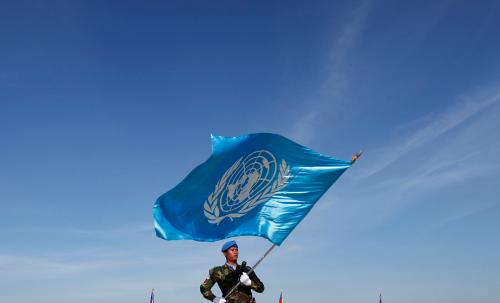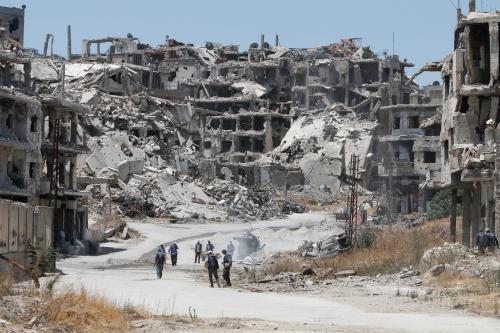By 2030, an estimated 80 percent of the world’s extreme poor will live in “fragile states” where violent conflict is the most concentrated and vulnerability to natural disaster and climate change is on the rise. The current paradigm of promoting economic growth and poverty reduction will not work in the hardest places. Instead, responding to the challenges of fragility will require a new paradigm focused on sustainably meeting basic needs for hundreds of millions of the most vulnerable persons, managing shocks and stress that disrupt development, and addressing the root causes of fragility. None of these challenges can be properly addressed without working at scale. This is not simply a matter of expanding successful programs to reach more people. Instead, we argue that the most promising interventions for tackling fragility and building resilience only “kick-in” at scale because of the higher degree of functioning social capital they require. While not a panacea, scaling-up approaches provide a valuable organizing framework for strengthening and expanding social capital and overcoming the piecemeal, one-off, and non-strategic character of aid projects in fragile states.
Scaling as an organizing framework
Fragile states by definition face higher risks and insufficient capacities to deal with them at the community, state, or system level. Traditional pathways for service delivery—governments and markets—are often low capacity or otherwise compromised. In addition, international assistance is often piecemeal, short-term, and uncoordinated. Scaling frameworks offer a way to organize disparate capacities and resources among partners for the widespread and sustainable provision of basic services like health, water, and education. Scaling is arguably less risky than one-off projects.
Several frameworks seek to unpack and improve the process of scaling valuable interventions. Among the most widely disseminated is Management Systems International’s framework, which (see the figure below) has three objectives—designing interventions with scale in mind, assessing scalability, and enhancing the scaling process—and is organized into three steps. Step 1 focuses on establishing and testing scalable interventions and viable pathways. Step 2, establishing the preconditions for scaling, focuses on the “political” tasks needed to support scaling. And, Step 3 includes the organizational, coordination, and accountability tasks essential for large-scale delivery and quality control.
Adapting scaling frameworks to fragile states: The role of social capital
While the current development paradigm focuses on infrastructure development, skills training, knowledge transfer, and financing, in fragile states an outsized focus must be placed on meeting the biggest deficits in these contexts: relationships, norms, and trust between communities, networks, and institutions. Hence, the focus on “social capital,” which includes three inextricably linked elements:
- Bonding efforts within like-minded communities to strengthen social ties, promote self-help approaches, share information and assets, pool funds, and provide psycho-social support.
- Bridging efforts to bring together different communities with fewer shared interests to maximize capacities in the face of shocks and stress, as well as to mend divisions that can lead to conflict.
- Linking efforts to connect communities and local networks with formal institutions and governments to receive services, share information, and strengthen trust and responsive action in the face of crisis.
These activities are most effective as a comprehensive approach. Bonding without bridging can lead to insulated communities that strengthen inter-communal divisions; bridging without bonding leads to shallower forms of cooperation; bonding and bridging without linking confine efforts to the grassroots level without higher levels of financial support, leadership, information-sharing, or state legitimacy.
A comprehensive approach to social capital is only possible at scale since bonding and bridging must work within and across wide geographies and linking must work vertically from grassroots to sub-regional and national levels, as well as globally where larger value or supply chains are involved.
Studies have shown that when operating together, bonding, bridging, and linking efforts increase coping and adaptive capacities of communities to conflict and disaster. The World Economic Forum’s widely-regarded five R’s of resilience—robustness, resourcefulness, redundancy, response, and recovery—inherently require functioning social capital to socialize emergency protocols, direct resources, decentralize decisionmaking, share real-time information, incorporate fail-safe mechanisms, and ensure backup capacities exist when preparing, responding, and recovering from crisis. None of these efforts can be done without increasing social bonds of cooperation, bridging inter-communal divisions, and pooling diverse geographical capacities, as well as linking to governments and formal institutions for access to information, resources, and support.
Scaling approaches also present opportunities to help address the root causes of fragility—broken social contracts between state and society, social divisions, and weak institutions unable to provide basic services and protection. The current paradigm views state-sponsored service delivery as automatically conferring legitimacy on states and helping to mend social contracts. Recent studies have found that state legitimacy is a complex mix of historical and political legacies, fairness and inclusion, and service delivery. In many cases, improved services did not lead to greater state legitimacy, but instead drops in service quality or access decreased legitimacy and fueled tensions.
However, when combined with large-scale efforts to expand social capital, scaling approaches offer multiple ways of strengthening social contracts and state legitimacy in ways that piecemeal service delivery projects cannot.
Scaling through weak institutions
Achieving this level of scale will require new ways of working in extremely fragile contexts. There must be greater emphasis on hybrid platforms for scaling “ecosystems” that bring together capacities, resources, and legitimacy from formal and informal institutions as well as international partners to compensate for the inherent weaknesses of these actors working in parallel.
The Afghanistan package on basic health services shows how effective these type of hybrid platforms—between the Ministry of Health, international implementing partners, and communities—can be for scaling results, in this case, to meet the Millennium Development Goal of halving infant and maternal mortality by 2015. The “wave sequence” approach pioneered by the U.S. Agency for International Development and partners in fragile contexts like Afghanistan, Gaza, and Uganda shows how significant social capital is at accelerating scale, through scaling ecosystems that link formal and informal institutions, empower high performing teams, facilitate dynamic peer networks within and across communities and districts, and couch these activities in cultures of real-time learning, iteration, and adaptation. Scaling consortia like SomRep also offer ways of overcoming one-off projects and weak institutions in fragile contexts by aligning with government priorities, pooling multiple donor resources, sharing technical expertise between implementing partners, generating evidence and public campaigns, and empowering communities.
Scaling is not a silver bullet, but working at scale and through a social capital lens offers new routes for organizing and aligning resources, capacities, and partners to reach millions of people, and in the process can change underlying social and political narratives, relationships and perceptions of favoritism, resource distribution, and existing norms and networks. Those coordinating these processes must constantly manage risks, root causes, and resource provision, and they must crowd in various disciplines to help. These include the sector specialists in basic services and economic development, as well as experts in humanitarian response, peacebuilding, conflict resolution, political economy, resilience, and disaster-risk reduction. Hybrid platforms for scaling can encourage donors to join larger networks of in-country partners to pool funds, align priorities, and deliver results. While the challenges are extremely high, so are the stakes. We must find ways to tip the scales in favor of hundreds of millions of the most vulnerable people in the hardest places.









Commentary
Scalable solutions in fragile states
November 28, 2017